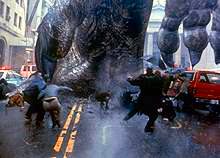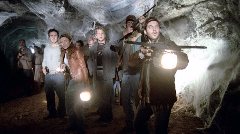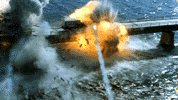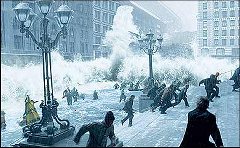Interview with Karen Goulekas, VFX supervisor
The visual effects supervisor of The Day After Tomorrow, 10,000 BC, Spiderman and The Fifth Element tells us about keeping it real...
Karen Goulekas has supervised visual effects work for such Hollywood blockbusters as Godzilla, The Day After Tomorrow, 10,000 BC (Yes, Roland Emmerich is very happy with her work!) and The Fifth Element as well as contributing to the likes of True Lies and Eight Legged Freaks…
How did you get into VFX?
I was a hands-on artist for ten years. I started in 1984 – I got my first job at a TV station right out of school, in Providence, Rhode Island. In college I had studied television and journalism – I didn’t take any computer courses, no arts, visual effects didn’t exist, and when I got to the television station, for part of the job I was a camera operator and did Chyron for the weather stats. They bought one of the first 3D computers – it was called the Dubner – I don’t know if you’ve ever heard of it. It was a Dubner CBG-2. There was Chyron and a 3D animation system, there was no texture map, no light sourcing, but it had real-time playback, which was great for television.
And this was in the mid-eighties?
Yeah, exactly, it was 1984. And I got hooked, in a way. I remember the chief engineer of the company taught me how to program and edit and I was off on my way. Within six months I knew the thing inside and out…
And this was full 3D?
Yeah, full 3D computer. There was one company that used them in Boston, and I heard that their one Dubner artist was going back to film school, so I drove up there with my demo reel and I got hired on the spot. That was at a commercial house, Video1 in Boston. So then I spent three years in Boston, then I went down to New York, and I was just a freelance digital artist. I just had log-ins everywhere in town. By then I was a Wavefront artist, and I had gone through Cubecomp and Digital, a whole slew of systems, and finally ended up on Wavefront, when that came out. As a freelancer I worked on the Olympics packages – up to then I was doing ESPN, flying logos in commercials. And then I got a couple of Emmys at the ’92 Barcelona Olympics, and I just wanted to get into film after that.
It can’t have been a complete surprise, your passion for digital effects, when you were growing up – were you particularly interested in sci-fi, or special effects then?
No, not at all. I wanted to work in commercials, I thought commercials were great. I wanted to be a writer, and it was mostly because I couldn’t draw. So writing became, by default, the creative outlet, But when I got onto a 3D computer, suddenly I could make pretty pictures. They were in the correct perspective, and that was when I said, “Oh my God, this is what I want to do.” And it wasn’t until…honestly, it was Terminator 2 that made me say, “I’ve gotta go work on film.” And I remember I came back from the ’92 Olympics, went back to New York and started sending my demo reel out to everyone in California, and everybody bid, and they were all calling me; the problem is they were all offering anywhere from half to about a quarter of the money I was making from being a freelancer in New York. So I had log-ins at every company, I made sure I charged more than everybody else in the city, it was totally crazy, working night and day. Finally, Boss Films’ Jim Reigel brought me out for a commercial, and it was at about half my rate. And that was the highest that anybody was going to offer. So I went for three months to do a commercial at Boss Films, and I loved it. My husband and I had been wanting to move out for a long time. So we just said ‘to hell with it’, and we moved out, and Boss Films was where I worked on Last Action Hero.
Were Doug Trumbull and Richard Edlund there in that period?

And Eight Legged Freaks as well, a favourite of mine…

During the video interview for 10,000 BC you mentioned a whole swathe of applications you used from Maya to Shake I didn’t think there was anyone left in the VFX pipeline who did more than one thing. It seems from the outside to be extremely compartmentalised. As a visual effects supervisor, how hands-on is it for you now?

I can understand that someone with a passion for Photoshop might end up as a texture artist, but what about the huge number of very specific jobs like animating rigs? I can’t imagine someone at the age of eight thinking, “I want to grow up and animate rigs.” Are these jobs that people are passing through on the way to something else, or are there people who genuinely have a passion for these very, very particular stages in the pipeline?
Oh I think it’s both – I think sometimes people start building rigs, it might be a technical director who wants to move into character animation, so it could be a transition point to show he knows rigs, and can do tests with the rig and show that he has a sense of motion, and then hope that the company will let him animate some shots. Other people, they just love it. How do you make it work? How do you make it fluid…? I mean, some people love to write shaders, other people are just really good at it, and really good at math, and then they feel like they’ve been pigeon-holed and they can’t get out of it because it’s so hard to find good people to write really good Renderman shaders.
What’s the right temperament to work in the VFX pipeline? We kind of imagine they’d all be geeks, they’d all be fairly introverted and they’d all be sitting at little workstations…
Oh, not at all. I don’t think so. I think because basically what draws you there is art, and a love of film. So I think you get very colourful people, very animated – every company has a different ‘vibe’, but I wouldn’t call the artists ‘dull’ or ‘geeky’ for the most part at all. I think they’re very lively and creative, for me some of the best fun is interacting directly with the artists.
Of course. Everyone’s feeling the pinch at this particular moment in the economic climate – people seem to think films are recession-proof. Is there some general worry in the industry about the next year or so?
Well, I think the past year has been more of the worry. When I got done with, it was right in time for the writers’ strike, and nothing went on for a while. Then, when the writers’ strike lifted, it was kinda like ‘Yay!’, but only a handful of movies actually got green-lit between the time they settled and the actors said they weren’t going to accept their contract on June 30th.
And so since that time it’s really…it’s been pretty stalled. I mean, the number of films that are green-lighting is definitely down. Which means that everybody was expecting 2009 to be huge because you’ve got to get the 2010 and 2011 slate ready. It’s sounding like the actors won’t strike, so that’s a good thing. But yes, of course, there is the recession – I think in general Hollywood’s rethinking the movies. I don’t think they’re going to want to be spending as much because it’s so give-and-take – is it going to be a big hit or not? Do you make a lot of money or do you not? It’s a tough one. And I think it’s actually good for us to have to get creative.
I’ve been over to India last year covering a Bollywood film, I went to Taiwan and I was checking out some companies there, I just think it’s going to keep expanding in that direction, and there’s a lot of budgetary reasons why it’s good for us to do work there, and it’s just about thinking creatively. And where do I need to do the really difficult work? Ok, I’m going to still think about LA, and London, and Australia and Canada and places like that, and then you start to think, “What’s the mid-level work? Where can I bring that next?” And where’s the paint-work and can I do all that in India or China? Or do I just hire my own in-house team? It’s kinda fun because it means you’re not just limited to one location, you look out in the world and you say ‘what’s the best place, what’s the smartest?’. Of course, we’re driven by tax breaks too; I don’t necessarily have a choice where I work. Often, if I’m on a movie like 10,000BC, you had to do all the work in London. That was fine, all the companies were fantastic, but it wasn’t like I could just take it anywhere. Now I’ve got to figure out how to make it fit within the companies that are here, and their availability and resources.
So there’s a lot of assessment involved in the job.
There is, and it changes on every film, because Company X can be fantastic for you on one film. But then maybe three years later you go back – I tend to be on a film for two years or so at a time – and that doesn’t mean that that same group of artists is there. The company can be completely different, they could have gone in a different direction, you still need to go every time and see who’s come up. Some company that you didn’t think was ready for the work three years ago is totally ready for the work now. So definitely, every show you re-evaluate, but…it does depend a lot on the tax breaks initially, on where you need to go, and sure, I mean there’s a lot of good people out there.
In terms of budgetting one particular shot, is there a list of luxuries that gets picked off one-by-one if you’re under pressure? Such as perhaps samples and motion blur, texture resolution…? What are the order in which these things might fall by the wayside under pressure?
Well, you never would let go of texture resolution or motion blur.
One visual effects artist from London commented on our ‘Top 50 Movie Special Effects’ piece that if there’s a certain number of samples needed for motion blur but one needs to get the shot out in X number of days, it will get cut down. So this is why I asked…
Well, I shouldn’t say ‘never’ – I mean, the bottom line is that if you can reduce the texture resolution and it doesn’t affect the quality of the image, then there’s nothing wrong with that. It’s just that if you start to feel that you’re filming a lesser quality, then you wouldn’t do it. But I mean there’s nothing wrong with cutting all the corners you can – at the end of the day it’s “what’s the impact of the shot?” Does the shot feel right to you? If there’s something jarring in it then you gotta go back and say, “OK, we need more motion blur, or we need higher resolution textures, or the model needs to be higher res…” But you know, everyone has smart models, they have medium- and low-res geometry – there’s nothing wrong with that as long as it doesn’t show.
Do you ever get told that a shot that you’ve made look absolutely perfect doesn’t have enough dramatic impact by the director?
Well, who’s saying it looks perfect – the artist that created it?
Your own view.
That’s a subjective thing – what one artist who’s slaved over the shot may see as perfect may not be perfect in the context of the editing of the film and the music and the colour and the style. But you hope that you spot that before they take it all the way to final. That’s hard to know – how often is the director and the editors and the production team meeting on it? That changes with every show as well, if you’re working remotely or you’re going visiting them daily or they’re sending you work daily…the word ‘perfect’ is….you know [laughs].
Very subjective.
What is perfect, you know? Finally, it’s in the director’s vision at the end of the day, and what fits into their film, and we all have different opinions about it, I think.
What’s your favourite CGI shot that you didn’t do yourself?
Um….well I remember I was blown away by Terminator 2. Just in general – the guy was walking through the bars of the jail and what’s amazing to me is that those shots still hold up. They’re still really good. And of course I was impressed with Gollum. Latest…in Benjamin Button I thought the face work was fantastic; I thought Iron Man and Dark Knight were flawless…I don’t know if there’s just one shot; I think it’s just the feel when I watch a movie. And if I was jarred out of the story at any time because the visual effects maybe didn’t work, or the editing or anything else – I watched The Dark Knight and I wasn’t thinking about visual effects.When you see bad CGI, is there a common problem to it? Or is it just happenstance that somebody didn’t composite or somebody else didn’t get the motion right?
Well, if you have bad motion, and by ‘bad’ I mean it some way jars the eye, you may not know why right away, but the motion doesn’t feel natural, and you have the most spectacular, photo-real lighting in the world, you’re still going to be jarred by the shot. And the opposite is true – if you have fantastic, perfect, fluid animation that looks great in greyscale, but the lighting and shaders and texture, for whatever reason, isn’t fitting in there due to lighting and compositing, again, the shot pulls you out. Unfortunately, you can have five out of the six things perfect, but if the sixth thing – the lighting doesn’t fit on the plate, or there’s a hitch in the animation, or just something feels ‘off’ – unfortunately it can jar the eye, and the movie-goers aren’t necessarily going to know why. Even as a visual effects supervisor I look at a shot and I go, “Why? What just jarred me on that?” And that’s our job, to stare at it and look at it and say, ‘OK, I think this is what’s going on.’
I was amazed at the fur on the mammoths in 10,000BC and was really knocked out by the wet fur on the trapped sabretooth…does a problem like that need to be approached totally from scratch, each and every time, because all the software’s changed and all the libraries are out of date and legacy meshes won’t work with the new system? Is there nothing you can bring from previous work?


Is there anything you already know of coming up in processing technology, or in-the-pipeline technology that really excites you, for the next two or three years in terms of speeding up render times?
I’ve got to say I don’t really keep up on that that much. When I’m working with the vendors I ask for benchmark tests and we talk about it, but I’m certainly not the one that’s hands-on evaluating the tool-sets any more. I defer to the specialists at the companies to say, ‘Hey, we’ve got this really cool system we’re going to use on this.’
You were chatting before about the amazing Tweak Films work on the Manhattan flooding sequence in The Day After Tomorrow. Can you tell us something about the particular challenges of not only rendering but calculating water movement? It seems on a par with calculating the weather and that you would need gigaflops of processing power to actually accomplish it.

But they could also modify it, because again we’re working to music and editorial timings, and maybe the first simulation would come out and a wave would hit a building on the top of a screen before a big splash would hit a building smack in the middle. Naturally the director would say, ‘That’s such a cool wave, can we re-time it a bit so that the centre wave coming down the middle of the street hits the big building in the middle of the frame first? Because that’s where our eyes are going to be and let the rest happen.’ And you know what, they were able to do that! They’d say, ‘OK, we’ll get that back to you in about an hour.’ I don’t know how they did it. You’d have to ask Chris, but it blew our minds. We were just so impressed with the flexibility, I’ve never seen anything like that, you just don’t expect it to be that flexible. When it was, we were so relieved, because now we could art-direct the timing of the water in the scene.
Because generally if you’re a fair bit more committed, I imagine a change could take up to a week, take up to a month in certain instances.
Exactly, because you’re getting in and now you’re trying to manipulate what the software wants to do, and the math…sometimes it comes out easy right away, or tricky – there’s all different reasons why the water will blow up. But you know water in general…[Day After Tomorrow] came out in 2004, and now, nearly five years later, water’s not the beast that it was. Everybody’s doing water. It’s still not an easy thing but it’s not that daunting, ‘Oh my God, how are you going to do this water?’ like it was when they first did it in A Perfect Storm.
What’s the challenge now? Eyes? Textures?
I think what Benjamin Button did was really cool. It shows that it can be done, and we’re going to keep seeing uses. I’m doing a test now where I’m recreating a historical character, and that’s tricky because I can’t take that historical character and cyberscan, and photograph, and do facial capture. So it makes it a next step of complexity.
I was going to ask you what your current projects were, if there are any you can mention?
Mostly it’s tests for a film right now, doing some consulting in India – the tests are something for a potential future role in a Roland Emmerich film, and I’m doing it with Double Negative. I’m supposed to be directing a piece for the Taipei Expo in Taiwan, but that went on hold due to the global recession… [laughs] Everything’s getting hit there. And then interviewing for films that are starting up in 2009. Most of them aren’t green-lit yet, but at least the studios are getting a slate together. There are a lot of balls in the air, and one of the balls will land eventually and I’ll probably be up to my eyes in something new, as opposed to having a handful of projects going.
I noted one article on women in visual effects, where you were featured, and women seem very well-represented in the industry. Do you consider that there’s any kind of barrier for women regarding your own, higher-level supervisor position?
No, if I did I wouldn’t be here doing the position, you know what I mean? Sure, there’s jobs in the past that I didn’t get – now do I know that I didn’t get them because the director didn’t think I was the right person for the job, or was there another candidate they thought was stronger, or because I was a woman? I tend to think not – I think if they call you in in the first place and they meet you, it’s because they’re looking at all the candidates and figuring out personality, vision, skill sets and picking out the best person for the job. It’s hard for me to think that anyone really cares about if you’re a man or a woman. But I’m sure that exists, to some extent. But I can’t tell you that I personally know that that’s ever happened to me.
What are your ambitions in the field? Would you be happy as a producer further away from the cutting-edge of actually generating the pipeline?
I love visual effects. But I also realise that what I’m doing is such a narrow band, you know, waiting for that handful of tent-pole pictures to come out…I’d love to direct for full CG. And definitely exploring the idea of producing. I’m definitely open to expanding. I’m checking out games, I would love to direct cinematics, because it’s just like doing pre-vis and post-vis on the visual effects movies, which is probably my favourite part which is definitely pre-vis and animation. So I’d say those were the goals, it’s definitely to break into feature animation.
As a consumer, could I ask why DVD extras about special effects are so bad?
You know what? At least in my opinion, they do them too early. In both The Day After Tomorrow and 10,000 BC there’s nothing wrong with the pieces, they were well-edited and the team put them together well, but the bulk of the interviewing was done while we were shooting on location. And then later they’ll go to the facilities. I don’t think they’re but, it’s just how in-depth do you go?Maybe they should put out a ‘Nerd Edition’ for the likes of me who would actually like to know a little bit more than ‘it was done with computers’.
That’s the thing, they’re gearing it towards the average home viewer who’s not excited to see, ‘This company did this, and that company did that’. It’s hard. but they try to get an interview early while you’re shooting, and then they’ve always come and followed up with me afterward and we tell them, ‘these are the facilities where they’ve done the key sequences’, and it seems they’ve always gone to the facilities and let them do their show-and-tells, and I think they end up with way more material than the time they’re allowed on the DVD. That’s part of the problem because everybody shows them everything. It’s all there but I think they’re probably told they can only do this for five minutes. And how do you sum up a film in five minutes when you’ve had all these renderers who have showed you terrific, ‘This is how we did the fur, and the water, and…’ – you could go on for an hour!
That’d suit me. Karen Goulekas, thank you very much!
More VFX interviews:
JOHN DYKSTRA From pioneering effects work on Star Wars through to Batman, Spiderman and Hancock, John Dykstra is an SFX legend…
ANGUS MACLANE of PIXARAngus MacLane, the supervising animator on Wall-E, talks about the secrets of Pixar, the joys of Lego, R2D2 and his love for James Camerons’ Aliens…
TOM WOODRUFF Jr.The man who has made and worn the ‘Alien’ suit in all the movies since Aliens talks with DoG about his extraordinary trade, CGi and prosthetic Hulks…
More effects stuff…
TOP 50 MOVIE SPECIAL EFFECTS SHOTS There’s more to a great visual effects shot than iconic status, and here are fifty that really paid their way…
TOP 24 WORST SPECIAL EFFECTS OF ALL TIME Sometimes the effects just aren’t very special, as these videos will prove…

28 January 2009
